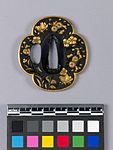tsuba (Sword Guard)
About this object
History of use
Tsuba, sword guards, are placed between the hilt and blade of a sword, forming an essential guard for the hand, while giving the sword balance. Known to exist in Japan since at least the 8th century, they were plain unsigned metal until about the 16th century, when they became enriched artistic expressions usually made to the order of the individual warrior. The owner’s identity, beliefs and tastes were reflected in the symbols the tsuba bore. It is possible this predates the custom of artists signing their work. The central opening, nakago ana, holds the tang of the blade and often has chisel marks or soft metal inserts as adjustments. It is surrounded by a plain surface, the seppa dai, on which the artist's signature may be found. On either side are the kodzuka and kogai openings, for a knife and a skewer respectively; when both are open the guard is intended for a wakazashi blade (less than two feet) and when one or both are plugged or absent the guard is probably intended for the longer katana blade. This tsuba only has the nakago ana and kodzuka openings, for a katana and utility knife respectively. The delicate decoration suggests this blade was meant for court use, rather than fighting.
Narrative
Marion Stephan Collection.
Iconographic meaning
The chrysanthemum is a symbol of autumn.
Specific techniques
The shakudo metal, a bronze with 3% or more gold, was pickled to achieve the blue-black colour.
Physical description
Four-lobe shaped metal sword guard with raised gold rim, nanako (minute raised dots) background; seppa dai of highly polished shakudo, unsigned, shows chiseled adjustment marks; open kodzuka, no kogai. Front: pattern of chrysanthemums, cherries, and butterflies, in low relief overlaid in gold, stems in polished shakudo. Back: similar pattern.
Categories
Materials
Date Made
1675-1700
Date Acquired
10 Jan 1977
How Acquired
Donated
Credit Line
Measurements
Overall: 6.4 cm x 5.8 cm
Object Number
Ed5.3143
